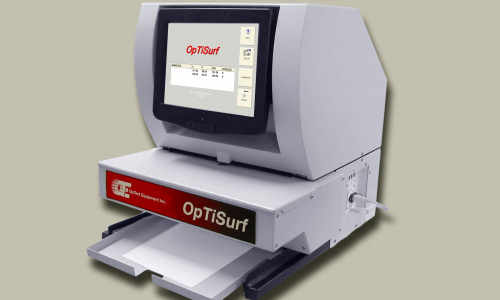The OpTiSurf uses advanced optics and algorithms to quickly quantify the optical roughness of sheets. OpTiSurf is more objective compared to air-leak or stylus methods, correlates with traditional air leak tests but has greater precision and speed, with less maintenance. The OpTiSurf gives an Index of Roughness as well as Roughness values at different size scales.
Translation provided by Google
OpTiSurf - OpTest
OpTiSurf
| Product Name | OpTiSurf |
| Product Code | LFA06 |
| Test Material | Paper, Tissue, Board |
| Manufacturer | OpTest Equipment Inc. |
| Availability from OpTest | Worldwide |
The OpTiSurf revolutionizes the measurement of surface roughness of paper!
Using advanced optics and algorithms, it quickly quantifies the optical roughness of entire sheets. The OpTiSurf correlates with traditional air- leak tests but has greater precision and speed, with less maintenance.
The surface roughness of most paper is an important property:
• Roughness strongly influences the sensation of handling the paper, which can have complex effects on the subjective assessment of quality, depending on the type of paper and its application.
• Roughness has a direct effect on print quality for most printing technologies, and it is often related to other physical properties of practical significance such as friction or glue adhesion.
• Surface roughness is typically determined by air-leak methods. These methods are time consuming and lack adequate precision.
The OpTiSurf offers a fast, repeatable, objective instrumental determination of surface roughness of paper.
ADVANTAGES
• Non-contacting
• Applicable to most types of paper, including tissue papers, porous and conformable sheets that cannot be measured by air-leak methods
• Accepts cut sheets or strips up to 30cm wide
• Calibrated using known roughness material
• Comparison with user selected reference samples
• Image storage and retrieval, Excel™ ready data and print-outs
• Faster, more precise and objective compared to air-leak or stylus methods
• Optical Roughness Index correlates with air-leak methods
• Roughness Intensities (FFT) over a size range from 0.25 mm to 32 mm
• MD and CD values
RESULTS
The Optical Roughness Index (ORI) is reported in units of µm. The ORI may be measured in the machine (MD) and cross machine (CD) directions. Individual measurements are saved and reported as an ORI profile and average values. The user may save individual images used in the analysis. Reports are provided in several formats, including XML.
Frequently two samples have differences in Roughness Intensity, at a specific size scale, which are much greater than observed by the ORI alone. The optional FFT analysis software determines the Roughness Intensity at 7 size ranges (components). The Relative Roughness Intensity is then calculated by comparing the values of a "test" sheet with the values of a "reference" sheet selected by the user.
FEATURES
• Precise optics & illumination
• Solid-state light source with a long life
• Spatial resolution of 125 µm /pixel
• Roughness (ORI) calibrated to 0.01 µm / field
• Paper strip profiling capability
• Rapid measurements (< 1 s / field)
SAMPLE REQUIREMENTS
• Flexibility = wrap a cylinder of 15 cm diameter
• Thickness < 2 mm
• 45° Gloss < 95%
• Brightness > 20%
• Opacity > 50%
• Width > 10 cm
• Length > 20 cm for automatic operation or - > 10 cm in manual mode
OPTIONS
• Roughness Intensity (FFT) Spectra
DIMENSIONS
• Instrument: 58cm L x 50cm W x 60cm H - (22” L x 20” W x 24” H)
• Weight: 45 kg
CONNECTIONS
• 120Vac/60Hz or 240Vac/50Hz, 1 phase, 600 W min.
• The power must be stable, within 2%, and transient free within ± 10%.


